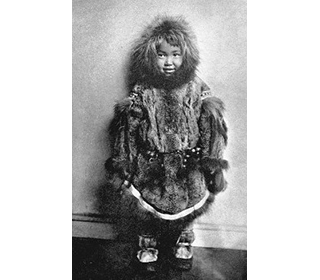One of the major elements used by many of the Arctic tribes was the addition of a fur ruff that was attached to the hood, hem, and cuffs of their parkas. The natural resources used to make fur parkas were superior to many modern synthetic materials and provided excellent insulation against bitter, cold weather conditions. Fur Parkas Fact Sheet - Parka Definition: A parka is a knee-length cold weather hooded coat that was originally worn in the Arctic, made from animal skin and often stuffed with down and fu on the inside and trimmed with fur around the hood, cuffs and hem.
- Fur Parkas Fact 1: The word 'parka' is derived from the Russian language meaning "jacket". Russian explorers and traders established permanent settlements and trading posts in Alaska during the 1700's and used the word to describe the outer clothing worn by the indigenous tribes of the region
- Fur Parkas Fact 2: In Greenland the parka is called an anorak
- Fur Parkas Fact 3: Parka designs varied from region to region. Most had attached hoods although some designs featured detachable hoods.
- Fur Parkas Fact 4: The design of the parka was both flexible and adaptable. During the freezing winter months hunters wore one or two inner parkas, plus an outer parka for maximum warmth and insulation
- Fur Parkas Fact 5: Insulation saves body heat by layers of air trapped in the fibers stitched between layers of fabric. The air pockets between the layers of the garment act as an insulation
- Fur Parkas Fact 6: The parka hoods were usually trimmed with Arctic wolf or wolverine fur, husky dog fur, coyote fur or with the tail of an Arctic fox. The white fur of the caribou's belly was used for trim
- Fur Parkas Fact 7: The fur that trimmed the hood of the parka protruded past the face and acted as an effective wind break
- Fur Parkas Fact 8: The long fur cuffs helped to protect the wearer against frost bite. Blood comes close to the surface at the wrist, neck, head and ankles and cools rapidly. Unless these parts of the body are kept warm, the feet and hands soon freeze
- Fur Parkas Fact 9: The parka was ideal clothing to survive the bitter cold. The design also acted as a wind break. Wind carries off body heat unless clothes are wind-proofed
- Fur Parkas Fact 10: Dressing in layers was necessary to keep warm. Two parkas were worn, one with the fur against the skin and the second parka with the fur on the outside
- Fur Parkas Fact 11: The Short waisted inner parka was worn with long, narrow back tails, and wrist-length sleeves
- Fur Parkas Fact 12: The parka worn by an Inuit woman (amauti) was distinguished from a man's parka by elongated hoods, and exaggerated, pointed shoulders. A woman's jacket was also made large enough so a woman could carry an infant next to her body
- Fur Parkas Fact 13: The boys wore a parka that was cut straight across at the bottom with no slits on either side of jacket. It was called an 'akutuinnaq'
- Fur Parkas Fact 14: The men wore a parka with slits on both sides, called a 'qiapaujaq'
- Fur Parkas Fact 15: Clothing and skin preparation had a special meaning for the Inuit who believed that the symbols that adorned the parka provided spiritual protection. Symbols of predators were sewn into the parka in the belief that these guided the hunter in his quest for prey
- Fur Parkas Fact 16: The people of the tribes had two distinct types of parka, one for the summer and one for the winter. Their designs differed according to the temperature of the environment. The traditional winter parka, called a 'qulittaq', was essential for protecting the upper body from dangerously cold temperatures
- Fur Parkas Fact 17: Modern parkas are often based on the traditional Inuit design and made to fit loosely, allowing additional clothing to be worn underneath
- Fur Parkas Fact 18: Modern methods and materials have been combined with the traditional parka design to produce a range of different Parka style products
For additional facts about Artic clothing refer to Mukluks. |
